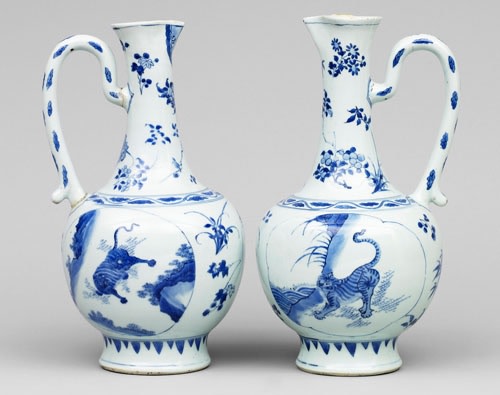AZ23 AZ24
Of pear-shaped form, with globular bodies small pinched pouring lips and bracket handles, on short spreading feet, each finely painted in underglaze blue with two large cartouches on either side, one with the unusual decoration of a tiger, the other with a dragon, on one ewer the tiger appears in a rocky landscape and on the other it is standing close to the edge of the water, both tigers with distinctly striped bodies and long, thin tails, on one of the ewers the dragon is partially hidden in a cloud of mist, his protruding head painted with a fierce mien, the other dragon emerging from a softer cloud again well drawn with a scaly body and fierce mien, the tiger and the dragon together being the Daoist symbols of Yin and Yang, both panels set on a ground of scattered flower sprays including, large lotus flowers, bamboo and orchids, around the shoulder a band with stylized cloud-motifs, the necks again decorated with scattered flowers and grasses including prunus, bamboo and orchids, the handles decorated with stylised cloud-motifs, on one of the ewers a pendant stylized leaf painted below the pouring lip, around the feet a border of pendant stylized leaves, the recessed bases glazed.
Literature
Yin and Yang are the negative and positive principles of universal life. Yang signifies Heaven, Sun, Light, Vigour, Male, Penetration, the Monad. It is symbolised by the dragon and is associated with azure colour and oddness in numbers. Similarly Yin stands for Earth (the antithesis of Heaven), Moon, Darkness, Quiescence, Female, Absorption, the Duad. It is symbolized by the tiger and is associated with orange colour and even numbers. Valleys and streams possess the Yin quality.
The motifs of the bamboo, orchids, lotus and prunus all represent in Chinese symbolism amongst other ideas refined traits and moral supremacy.

